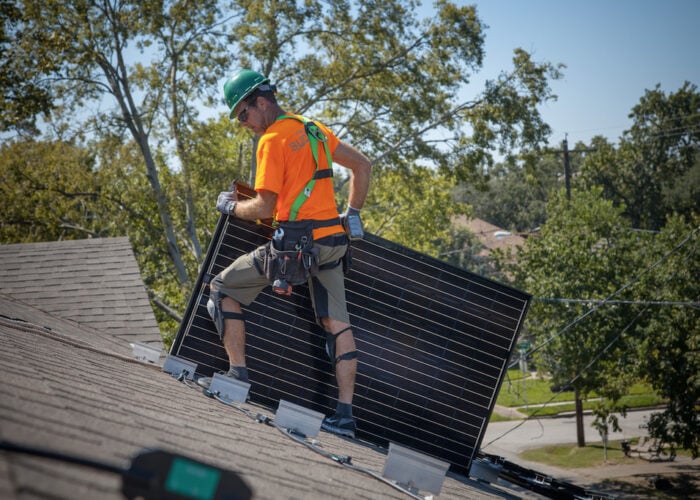A new study on the installed costs of solar photovoltaic power systems in the U.S. shows that the average cost of these systems declined significantly from 1998 to 2007, but remained relatively flat during the last two years of this period.
“Tracking the Sun: The Installed Cost of Photovoltaics in the U.S. from 1998–2007” was written by Ryan Wiser, Galen Barbose, and Carla Peterman, researchers at the Department of Energy’s Lawrence Berkeley National Laboratory. They say that the overall decline in the installed cost of solar PV systems is mostly the result of decreases in nonmodule costs, such as the cost of labor, marketing, overhead, inverters, and the balance of systems.
Unlock unlimited access for 12 whole months of distinctive global analysis
Photovoltaics International is now included.
- Regular insight and analysis of the industry’s biggest developments
- In-depth interviews with the industry’s leading figures
- Unlimited digital access to the PV Tech Power journal catalogue
- Unlimited digital access to the Photovoltaics International journal catalogue
- Access to more than 1,000 technical papers
- Discounts on Solar Media’s portfolio of events, in-person and virtual
“This suggests that state and local PV deployment programs—which likely have a greater impact on nonmodule costs than on module prices—have been at least somewhat successful in spurring cost reductions,” according to the authors, who work at the lab’s Environmental Energy Technologies Division.
Installations of solar PV systems have grown at a rapid rate in the U.S., and governments have offered various incentives to expand the solar market. “A goal of government incentive programs is to help drive the cost of PV systems lower. One purpose of this study is to provide reliable information about the costs of installed systems over time,” said Wiser.
The study examined 37,000 grid-connected PV systems installed between 1998 and 2007 in 12 states. It found that average installed costs, in terms of real 2007 dollars per installed watt, declined from $10.50 per watt in 1998 to $7.60 per watt in 2007, equivalent to an average annual reduction of 30 cents per watt, or 3.5% per year in real dollars.
The researchers found that the reduction in nonmodule costs was responsible for most of the overall decline in costs. This trend, along with a reduction in the number of higher-cost “outlier” installations, suggests that state and local PV-deployment policies have achieved some success in fostering competition within the industry and in spurring improvements in the cost structure and efficiency of the delivery infrastructure for solar power.
The study revealed other information about differences in costs by region and by installation type. The cost reduction over time was largest for smaller PV systems, such as those used to power individual households, and installed costs also show significant economies of scale. Systems completed in 2006 or 2007 that were larger than 750 KW averaged $6.80 per watt, while those less than 2 KW averaged $9.00 per watt.
Installed costs were also found to vary widely across states. Among systems completed in 2006 or 2007 and less than 10KW, average costs range from a low of $7.60 per watt in Arizona, followed by California and New Jersey, which had average installed costs of $8.10 per watt and $8.40 per watt, respectively, to Maryland’s high of $10.60 per watt.
Based on these data, and on installed-cost data from the Japanese and German PV markets, the authors suggest that PV costs can be driven down through sizable deployment programs.
New construction market offers cost advantages for residential PV systems, according to the study. Among small residential PV systems in California completed in 2006 or 2007, systems installed in residential new construction cost 60 cents per watt less than comparably sized systems installed as retrofit applications.
The study also found that direct cash incentives offered by state and local PV incentive programs declined over the 1998-2007 study period. Other sources of incentives, however, have become more significant, including federal incentive tax credits (ITCs). As a result of the increase in the federal ITC for commercial systems in 2006, total after-tax incentives for commercial PV were $3.90 per watt in 2007, an all-time high based on the data analyzed in the report. Total after-tax incentives for residential systems, on the other hand, averaged $3.1 per watt in 2007, their lowest level since 2001.
Because incentives for residential PV systems decreased over this period, the net installed cost of residential PV has stayed relatively flat since 2001. At the same time, the net installed cost of commercial PV has dropped — it was $3.90 per watt in 2007, compared to $5.90 per watt in 2001, a drop of 32 percent, due in large part to the federal ITC.
The research was supported by funding from the U.S. Department of Energy’s Office of Energy Efficiency and Renewable Energy (Solar Energy Technologies Program) and Office of Electricity Delivery and Energy Reliability (Permitting, Siting and Analysis Division), and by the Clean Energy States Alliance.







